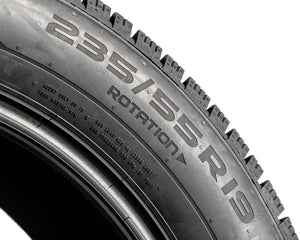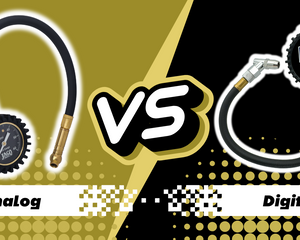As a driver, you're probably familiar with the concepts of tire pressure and grip, but have you ever wondered about the science that ties these two together? Tire pressure and grip play a critical role in ensuring that your vehicle responds optimally, whether you're on a racetrack, a dirt road, or your daily commute.
The relationship between tire pressure and grip is crucial to understand, not only for the performance of your vehicle but also for safety reasons. Accurate tire pressure contributes to optimal tire grip, ensuring better handling, shorter braking distances, and reduced risk of tire-related accidents.
In this article, we delve into the science behind tire pressure and tire grip, shedding light on how these two variables interact and affect your driving experience. Understanding this relationship empowers you to make more informed decisions about your vehicle's maintenance and aids in achieving a safer, smoother, and more efficient ride.

The Science of Tire Pressure
Tire pressure, in essence, is the force exerted by the air inside a tire. It's a crucial variable in the performance equation of your vehicle and affects everything from fuel efficiency to handling, comfort, and safety. Properly inflated tires ensure a vehicle's optimal contact with the road, thereby enhancing its grip, stability, and performance.
How tire pressure is measured
Measurement of tire pressure is commonly done in pounds per square inch (PSI), although other units such as bar or kilopascal (kPa) may also be used depending on the region. PSI refers to the amount of air pressure that is applied to one square inch of the tire's interior area.
Checking your tire pressure is straightforward with the help of a tire pressure gauge, a tool designed to provide an accurate measurement of the air pressure inside your tires. There are different types of tire pressure gauges such as digital, dial, or stick gauges. The JACO ElitePro Tire Pressure Gauge, for example, delivers precise, accurate readings in PSI, crucial for maintaining optimal tire performance and longevity.
In the next section, we will delve into the relationship between tire pressure and tire grip, further emphasizing why understanding and maintaining correct tire pressure is essential.

Tire Grip: A Closer Look
Tire grip, simply put, is the friction between your tire and the road. It’s the force that keeps your vehicle from sliding while accelerating, braking, or cornering. Understanding grip is crucial for maintaining safety and achieving optimal vehicle performance.
Factors influencing tire grip
Several factors influence tire grip, but among the most critical is tire pressure. The right tire pressure allows the tire to distribute vehicle weight evenly across its tread pattern, maximizing the tire's contact area with the road and thus optimizing grip.
Apart from tire pressure, tire tread design, tire compound, and road surface also significantly impact tire grip. Tread patterns are designed to channel water away in wet conditions, thus enhancing grip, while the tire compound (the mixture of rubber and other materials) is formulated for specific performance characteristics. The type of road surface - whether it's dry asphalt, wet pavement, snow, or off-road trails - plays a major role in determining the amount of grip a tire can deliver.
Lastly, vehicle weight and speed can also affect tire grip. Higher speeds and heavier vehicles put more demand on tires, necessitating proper tire pressure for optimal performance.
In the upcoming sections, we will delve deeper into how tire pressure directly impacts tire grip, and why maintaining correct tire pressure is a key aspect of ensuring optimal grip and, consequently, vehicle safety.
The Relationship Between Tire Pressure and Grip
How tire pressure impacts grip
Tire pressure and grip are intimately connected. The amount of air in your tires, measured in units of pressure (PSI, or pounds per square inch, is a common unit), directly impacts the amount of contact your tires have with the road, which in turn influences grip.
The physics behind tire pressure and tire grip
The science behind this relationship lies in the tire’s contact patch - the part of the tire that touches the road. With the right amount of tire pressure, your tire will form an optimal contact patch, distributing the weight of the vehicle evenly over the tire's surface. This optimizes grip by maximizing the area of the tire tread that's in contact with the road.
Underinflation, or too low tire pressure, causes the tire's sidewalls to flex more, which can result in a larger but less effective contact patch. The center portion of the tire may not make full contact with the road, reducing grip and causing the tire to wear unevenly. Overinflation, on the other hand, can reduce the size of the contact patch as the tire becomes too hard, leading to less grip and a harsher ride.
The principle here is that air pressure controls the tire’s footprint, or contact patch. The footprint must be optimized to deliver the right balance of grip, tire wear, and ride comfort.
Understanding the physics behind tire pressure and grip helps drivers make informed decisions about tire pressure settings, ensuring optimal vehicle performance and safety.

Tire Pressure and Grip: In Different Conditions
The influence of tire pressure on grip varies with different driving conditions. Understanding these nuances is crucial for maintaining optimal control and safety.
In dry conditions, maintaining the manufacturer's recommended tire pressure ensures an ideal balance between grip and tire wear. This results in optimal vehicle handling and fuel efficiency. However, when the road surface changes, the story of tire pressure and grip becomes more complex.
In wet conditions, a slightly reduced tire pressure can increase the tire’s contact patch, thereby improving grip. But caution must be exercised to prevent underinflation, which can compromise vehicle stability and cause tire damage. It's also worth mentioning that tires with good tread depth disperse water more effectively, aiding grip on wet roads.
Off-road conditions, on the other hand, often require a significant reduction in tire pressure. Lowering tire pressure in off-road scenarios increases the tire’s contact patch, providing better traction on uneven and loose surfaces. Again, caution must be observed to avoid going too low and risking tire damage.
Understanding the impact of tire pressure on grip in these varied conditions can make a crucial difference in your driving experience. Regularly checking and adjusting your tire pressure based on the driving conditions can lead to improved handling, safety, and even tire longevity.
Finding the Ideal Tire Pressure for Maximum Grip
Optimizing tire pressure for maximum grip involves understanding the interplay between various factors. While there is no one-size-fits-all solution, some general guidelines can help you find the right balance.
The recommended tire pressure given by vehicle manufacturers is an excellent starting point. These recommendations are calculated considering factors like vehicle weight, tire size, and intended driving conditions to offer a safe compromise between grip, tire wear, and fuel economy.
However, you may want to adjust these pressures slightly depending on specific circumstances. For instance, you might reduce pressure for improved grip in wet or off-road conditions, as discussed earlier. On the other hand, increasing pressure slightly can enhance fuel efficiency and reduce tire wear during long highway cruises.
It's important to consider your vehicle's weight, tire type, and driving conditions when determining the optimum tire pressure. Heavier vehicles generally require higher tire pressure to support the weight and maintain grip. Similarly, performance tires designed for high-speed driving might require different pressures than standard commuter car tires.
The optimal tire pressure is also influenced by the driving conditions. Are you driving in the city, on the highway, off-road, or on a racetrack? Each scenario has its unique requirements for optimal grip. For instance, driving on a racetrack might require slightly higher pressures for maximum lateral grip during high-speed cornering, while off-roading might demand lower pressures for increased traction on loose surfaces.
Finding the optimum tire pressure for maximum grip requires an understanding of these factors and a bit of experimentation. Always ensure you're within safe limits and remember that regular tire pressure checks and adjustments are a fundamental part of vehicle maintenance.
Tools for Tire Pressure Management
Regularly monitoring and adjusting your tire pressure is essential for maintaining optimal grip and overall vehicle performance. An accurate and reliable tire pressure gauge is an indispensable tool in any driver's arsenal for this purpose.

Importance of tire pressure gauges
Tire pressure gauges provide precise readings, helping you ensure that your tires are inflated to the right levels for your driving conditions. Regular checks are particularly important before long trips, in changing weather conditions, or when transitioning from one driving environment to another (such as from highway driving to off-roading).
Recommended tire pressure gauges
We recommend investing in a high-quality tire pressure gauge for consistent and accurate results. JACO's range of tire pressure gauges offers precision and durability, no matter your driving needs. The JACO ElitePro Digital Tire Pressure Gauge delivers pinpoint accurate readings up to 200 PSI, making it suitable for a wide range of vehicles from cars and trucks to motorcycles and bicycles.
If you frequently drive off-road or in challenging conditions, the JACO FlowPro Digital Tire Inflator Gauge might be your ideal companion. With its robust design, built-in inflator, and a bright, backlit display, it combines convenience with functionality.
Proper tire pressure management, aided by a reliable tire pressure gauge, can significantly improve your vehicle's grip, performance, and safety. So make it a habit to check and adjust your tire pressure regularly.

Final Thoughts: Get a Grip on Your Drive
Understanding the relationship between tire pressure and grip is crucial for every driver. It enhances your driving safety, optimizes your vehicle's performance, and contributes to longer-lasting tires. Remember, achieving the right balance begins with regularly monitoring your tire pressure with a dependable gauge.
Ready to take control of your tire pressure? Explore the complete range of JACO tire pressure gauges and automotive accessories in our Shopify store. From precision gauges to inflators and tire care products, we've got everything you need to keep your tires at their best and your drive at its safest.
Shop Now at JACO!




